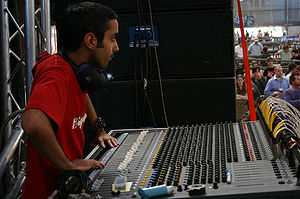Live sound mixing
This article needs additional citations for verification. (April 2014) |

Live sound mixing is the blending of multiple sound sources by an
Equipment
Audio equipment is usually connected together in a sequence known as the
EQ mixing involved adjusting each sound source's equalization (EQ) settings to achieve a desired sound. This involves adjusting the frequency, amplitude, and resonance of each sound source. EQ can be used to create clarity and depth to the mix, as well as to customize the sound of each instrument or voice.
Types
Front of house mixing

The
Foldback
The foldback or monitor engineer focuses on mixing the sound that the performers hear on stage via a stage monitor system (also known as the foldback system). The monitor engineer's role is important where the instruments and voices on the stage area is amplified. Usually, individual performers receive personalised feeds either via monitors placed on the stage floor in front of them or via in-ear monitors. The monitor engineer's console is usually placed in the wings just off-stage, to provide easier communication between the performers and the monitor engineer.
For smaller shows, such as bar and smaller club gigs, it is common for the monitors to be mixed from the front of house position, and the number of individual monitor mixes could be limited by the capabilities of the front of house mixing desk. In smaller clubs with lower- to mid-priced audio consoles, the audio engineer may only have a single "auxiliary send" knob on each channel strip. With only one "aux send", an engineer would only be able to make a single monitor mix, which would normally be focused on meeting the needs of the lead singer. Larger, more expensive audio consoles may provide the capabilities to make multiple monitor mixes (e.g., one mix for the
Drummers generally want a blend of all of the onstage instruments and vocals in their monitor mix, with extra volume provided for bass drum, electric bass and guitar. Guitar players typically want to hear the bass drum, other guitars (e.g., rhythm guitar) and the vocals. Bass players typically ask for a good volume of bass drum along with the guitars. Vocalists typically want to hear their own vocals. Vocalists may request other instruments in their monitor mix, as well.[3]
Broadcast
The broadcast mixer is responsible for audio delivered for radio or television broadcast. Broadcast mixing is usually performed in an
Sound checks and technical rehearsals
For small events, often a
Mics are set up for the
In the 2010s, many professional bands and major venues use digital mixing consoles that have automated controls and digital memory for previous settings. The settings of previous shows can be saved and recalled in the console and a band can start playing with a limited soundcheck. Automated mixing consoles are a great time saver for concerts where the main band is preceded by several support acts. Using an automated console, the engineer can record the settings that each band asks for during their individual soundchecks. Then, during the concert, the engineer can call up the settings from memory, and the faders will automatically move to the position that they were placed in during the soundcheck. On a larger scale, technical rehearsals may be held in the days or weeks leading up to a concert. These rehearsals are used to fine-tune the many technical aspects (such as lighting, sound, video) associated with a live performance.
Training and background
Audio engineers must have extensive knowledge of
According to professionals,[4] it is important to have both technical and creative skills. Technical skills involve understanding the principles of sound and acoustics, as well as being familiar with different types of audio equipment. This means understanding how to use equalization, compression, and reverb to create the desired sound.
See also
- Live event support
- Power alley
- Public address
References
- ^ "Mixing Principles". Leonard Audio Institute. Retrieved 2013-01-03.
- ^ Tim Crosby (28 April 2008). "How Live Sound Engineering Works". HowStuffWorks. Retrieved 2013-03-03.
- ^ a b Joe Shambro. "Monitor Mixing 101". Retrieved 2017-12-04.
- S2CID 192140775.
